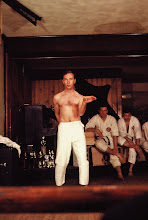Mr. Mattson"
On the suggestion of my sensei, Tracy Rose, from the Northboro dojo ,I hope that I am not being too forward by asking you for direction on a matter which I would like to eventually present to you in the form of a written essay...The topic is the anatomical/kinesiology correctness of the Uechi style (succinctly stated)
I have been a Uechi student for close to 17 years, presently a sandan, I am also a practicing physician for the last 35 years, specializing in cardiology. The more I practice the Uechi-style the more convinced I become of its anatomical correctness and its sound basis in human kinesiology (musculo-skeketal movement) to maximize strength movement and mechanical advantage (in other words: no mythical or supernatural powers...basically perfecting human body mechanics) .
I would like to explore this concept with any reference material or people in the discipline who have similar thoughts , in order to compose an essay...Many of the thoughts which I produce to my sensei and class are my own perceptions and interpretations...I would like to explore if there are other students or masters have thoughts which they could share
John Ferullo
[Hi John... Very interesting topic for discussion. With your permission, I'll post your letter on Bill Glasheen's forum and my mailblog]
Subscribe to:
Post Comments (Atom)

1 comment:
Mr. Mattson
I would be honored to have you post my letter
The thoughts that I have on the matter is as follows: The western forms of art science math etc. as compared to the eastern interpretation of many disciplines took place over thousands of years and were separated on vast space called the European-Asian (Eurasion) land mass. (I am quoting a former professor of mine from Harvard, named Edwin O. Reischauer). My proffessor had theories about the relationship of England to Europe and drew similarities with Japan off of mainland Asia
Although many of the various disciplines were developed somewhat differently, there are some similarities...even complementary. The perception a the human form as pictured by Di Vinci..has differences with the Uechi pose...but I find aspects which are very complementary
The Di Vinci human form shows an individual in the standard textbook form in a pose showing all of the muscles exposed with equal flexion and contraction showing the agonist group of muscles partially flexed opposed by their antagonist muscle equally flexed (e.g. the biceps and the triceps..the flexor muscle groups of the legs as well as the arms and the antagonist group). The other aspect of the Di Vinci illustration is that as one looks at the human muscular system as illustrated in the upright position, all of the muscles run from north to south, head to toe ...yet purposeful movement is "east to west" somewhat perpendicular to the Di Vinci model
Enter, the eastern interpretation of body mechanics...phrased karate (empty-hands). I think that at first impression, one would conclude...no weapons, no tools...The deeper meaning lies in uncovering the mechanical advantage which the human body has been endowed.
The Sanchin -kata, illustrates the basic principles. The initial pose muscles in a relaxed flexion state, the center of gravity, lowered ...the limbs pulled into the torso...the torso serving as the fulcrum for launching the strikes from the low center of gravity...firmly grounded.
I could easily go on and on...The thing that seems apparent to me is that the body mechanics which we utilized with regard to martial arts Uechi-style. are applicable to other things..such as a golf swing, a linebackers movement in football
I try to bring this out when asked or invited to participate in analysis of moves during class (certainly try not to usurp authority)
Would be interested in ideas from other practitioners//
Sincerely John
Post a Comment